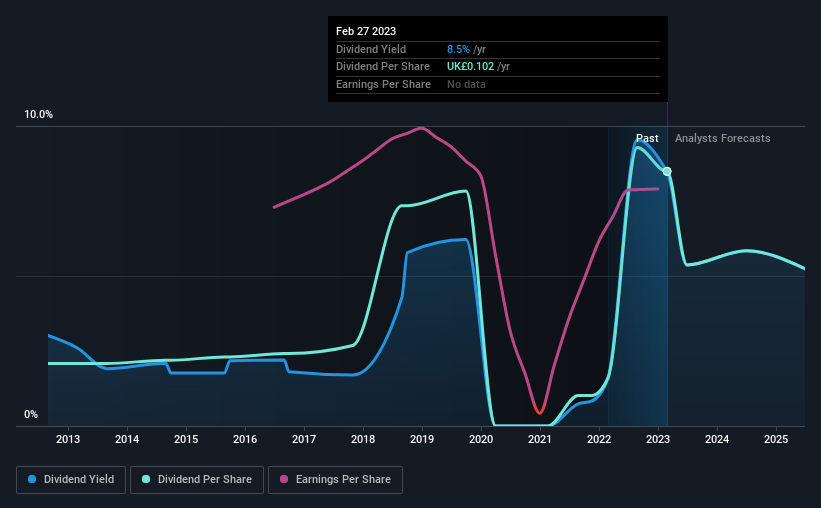Should Income Investors Look At Hays plc (LON:HAS) Before Its Ex-Dividend?
Regular readers will know that we love our dividends at Simply Wall St, which is why it's exciting to see Hays plc (LON:HAS) is about to trade ex-dividend in the next two days. The ex-dividend date occurs one day before the record date which is the day on which shareholders need to be on the company's books in order to receive a dividend. The ex-dividend date is an important date to be aware of as any purchase of the stock made on or after this date might mean a late settlement that doesn't show on the record date. This means that investors who purchase Hays' shares on or after the 2nd of March will not receive the dividend, which will be paid on the 11th of April.
The company's next dividend payment will be UK£0.0095 per share, and in the last 12 months, the company paid a total of UK£0.10 per share. Last year's total dividend payments show that Hays has a trailing yield of 8.5% on the current share price of £1.201. If you buy this business for its dividend, you should have an idea of whether Hays's dividend is reliable and sustainable. That's why we should always check whether the dividend payments appear sustainable, and if the company is growing.
See our latest analysis for Hays
Dividends are usually paid out of company profits, so if a company pays out more than it earned then its dividend is usually at greater risk of being cut. That's why it's good to see Hays paying out a modest 31% of its earnings. A useful secondary check can be to evaluate whether Hays generated enough free cash flow to afford its dividend. It distributed 31% of its free cash flow as dividends, a comfortable payout level for most companies.
It's positive to see that Hays's dividend is covered by both profits and cash flow, since this is generally a sign that the dividend is sustainable, and a lower payout ratio usually suggests a greater margin of safety before the dividend gets cut.
Click here to see the company's payout ratio, plus analyst estimates of its future dividends.
Have Earnings And Dividends Been Growing?
Companies that aren't growing their earnings can still be valuable, but it is even more important to assess the sustainability of the dividend if it looks like the company will struggle to grow. Investors love dividends, so if earnings fall and the dividend is reduced, expect a stock to be sold off heavily at the same time. That explains why we're not overly excited about Hays's flat earnings over the past five years. It's better than seeing them drop, certainly, but over the long term, all of the best dividend stocks are able to meaningfully grow their earnings per share.
The main way most investors will assess a company's dividend prospects is by checking the historical rate of dividend growth. Since the start of our data, 10 years ago, Hays has lifted its dividend by approximately 15% a year on average.
Final Takeaway
From a dividend perspective, should investors buy or avoid Hays? Earnings per share have been flat, although at least the company is paying out a low and conservative percentage of both its earnings and cash flow. It's definitely not great to see earnings falling, but at least there may be some buffer before the dividend gets cut. While it does have some good things going for it, we're a bit ambivalent and it would take more to convince us of Hays's dividend merits.
With that in mind, a critical part of thorough stock research is being aware of any risks that stock currently faces. For example, we've found 1 warning sign for Hays that we recommend you consider before investing in the business.
A common investing mistake is buying the first interesting stock you see. Here you can find a full list of high-yield dividend stocks.
Have feedback on this article? Concerned about the content? Get in touch with us directly. Alternatively, email editorial-team (at) simplywallst.com.
This article by Simply Wall St is general in nature. We provide commentary based on historical data and analyst forecasts only using an unbiased methodology and our articles are not intended to be financial advice. It does not constitute a recommendation to buy or sell any stock, and does not take account of your objectives, or your financial situation. We aim to bring you long-term focused analysis driven by fundamental data. Note that our analysis may not factor in the latest price-sensitive company announcements or qualitative material. Simply Wall St has no position in any stocks mentioned.
Join A Paid User Research Session
You’ll receive a US$30 Amazon Gift card for 1 hour of your time while helping us build better investing tools for the individual investors like yourself. Sign up here

